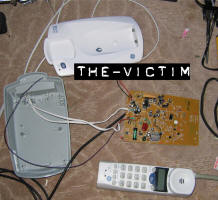
|
I’ve been a regular user of Skype for about a year now and have been using my own solutions to try to make this as user friendly as possible. But it was never perfect and I’ve always been the only one in my house using it as it hasn’t been user friendly. Then I heard about the Sipura and started looking around on how to use it, and then I heard about VoIPBuster which provided free VoIP calls to land lines all over the world. But – there’s always a but – it wasn’t as easy as I wanted it to be to get everything up running. I eventually figured out how to actually get a user friendly, transparent, phone solution up running and now anyone in my house can pick up any phone and the Sipura takes care of routing the call the cheapest way.
Here’s the How-To VoIP for free with the Sipura |
 Now this is an initeresting addition to the two previous VoIP hacks ( the Chat-cord and the Wireless Skype phone ). It’s achieving the same as the chat-cord project but as it doesn’t use a transformer it’s easier to build. Vitali writes:
|
 Onny looked at the Siemens Skype project and said to himself: Hmm, what about continuing on this and build in a Linux SIP server and make the phone ring when I have an incoming call. In five looong pages he describes in an amazing detail how he proceeded with his project, and this is not something for the faint of hart! It’s a lot of text!!! Read about the whole project at VoIP dect OSS Linux |
|
Ever wanted to connect a regular phone or a wireless phone to your computer to use with Skype or MSN? Jeroen, aka Mr. Blond, has done the thinking for you and has given us the schematics and pictures to do it. It’s easier then you think! Jeroen Theeuwes writes: “This whole project started with the fact that my girlfriend (we’re not living together) stopped using her home-phoneline (the contract became too expensive for one person), and I didn’t want to have to call her mobile every time, or using those stupid headsets. And as the chat-cord was not an alternative (not available where I live) I started thinking of building my own.” Read about his findings and see how you can build your own. |
 Ever wondered if people liked the Siemens skype project / Wireless skype phone project? Here’s the answer with a couple of pictures and experiences from other people who has done it! Link: Success stories |
|
Con s√ɬ≥lo un tel√ɬ©fono inal√ɬ°mbrico convencional, dos conectores de 3.5 mm, soldadura y algo de paciencia, un usuario de Skype fue capaz de construir un tel√ɬ©fono compatible con el popular sistema gratuito de llamadas por Internet. El procedimiento, ampliamente documentado en el sitio Web de Christoffer J√ɬ§rn√ɬ•ker, permite ahorrar los casi 120 euros que cuesta uno de los adaptadores disponibles en el comercio, seg√ɬļn informa Mouse. “√ā¬ŅC√ɬ≥mo funciona? √ā¬°Espectacular! La entrada de audio es perfecta y la salida suena algo fuerte pero se puede ajustar f√ɬ°cilmente desde el computador. Se siente como si realmente hablara por tel√ɬ©fono y ahora tengo un radio de 300 metros en el que me puedo mover”, relata J√ɬ§rn√ɬ•ker. Eso s√ɬ≠, el entusiasta usuario advierte que una vez modificado, el tel√ɬ©fono no puede volver a ser usado en forma convencional. “√ā¬ŅPero qu√ɬ© importa?. Funciona como lo quer√ɬ≠a”, exclama. En su sitio, tambi√ɬ©n destaca un procedimiento para agregar luz infrarroja a una c√ɬ°mara Web, permiti√ɬ©ndole ver en la oscuridad. Link: modificar un tel√ɬ©fono inal√ɬ°mbrico para usarlo con Skype |
|
So, the problem. You have a computer, your friend has a computer, you both have a broadband connection, and you make use of Skype or like the voice chat in MSN or something like this – And – you√Ę‚ā¨‚ĄĘre sick and tired to sit by the computer all the time when you talk. And you might even sit with one of these ridiculous headset (hmm, yes I also have one) on your head just because the echo cancellation feature isn√Ę‚ā¨‚ĄĘt that great in reality. Link: DIY Wireless Skype phone |
Help us continue our work with a donation
19 queries. 0.213 seconds